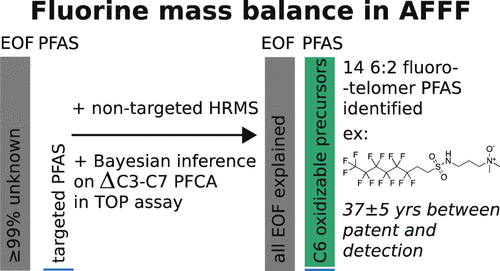当前位置:
X-MOL 学术
›
Environ. Sci. Technol. Lett.
›
论文详情
Our official English website, www.x-mol.net, welcomes your
feedback! (Note: you will need to create a separate account there.)
Reconstructing the Composition of Per- and Polyfluoroalkyl Substances in Contemporary Aqueous Film-Forming Foams
Environmental Science & Technology Letters ( IF 8.9 ) Pub Date : 2020-11-04 , DOI: 10.1021/acs.estlett.0c00798 Bridger J Ruyle 1 , Colin P Thackray 1 , James P McCord 2 , Mark J Strynar 2 , Kevin A Mauge-Lewis 3 , Suzanne E Fenton 3 , Elsie M Sunderland 1, 4
Environmental Science & Technology Letters ( IF 8.9 ) Pub Date : 2020-11-04 , DOI: 10.1021/acs.estlett.0c00798 Bridger J Ruyle 1 , Colin P Thackray 1 , James P McCord 2 , Mark J Strynar 2 , Kevin A Mauge-Lewis 3 , Suzanne E Fenton 3 , Elsie M Sunderland 1, 4
Affiliation

|
Hundreds of public water systems across the United States have been contaminated by the use of aqueous film-forming foams (AFFF) containing per- and polyfluoroalkyl substances (PFAS) during firefighting and training activities. Prior work shows AFFF contain hundreds of polyfluoroalkyl precursors missed by standard methods. However, the most abundant precursors in AFFF remain uncertain, and mixture contents are confidential business information, hindering proactive management of PFAS exposure risks. Here, we develop and apply a novel method (Bayesian inference) for reconstructing the fluorinated chain lengths, manufacturing origin, and concentrations of oxidizable precursors obtained from the total oxidizable precursor (TOP) assay that is generally applicable to all aqueous samples. Results show virtually all (median 104 ± 19%) extractable organofluorine (EOF) in contemporary and legacy AFFF consists of targeted compounds and oxidizable precursors, 90% of which are 6:2 fluorotelomers in contemporary products. Using high-resolution mass spectrometry, we further resolved the 6:2 fluorotelomers to assign the identity of 14 major compounds, yielding a priority list that accounts for almost all detectable PFAS in contemporary AFFF. This combination of methods can accurately assign the total PFAS mass attributable to AFFF in any aqueous sample with differentiation of gross precursor classes and identification of major precursor species.
中文翻译:

重构当代水成膜泡沫中全氟和多氟烷基物质的组成
在消防和培训活动期间,美国数百个公共供水系统因使用含有全氟烷基物质和多氟烷基物质 (PFAS) 的水成膜泡沫 (AFFF) 而受到污染。先前的工作表明,AFFF 含有数百种标准方法遗漏的多氟烷基前体。然而,AFFF 中最丰富的前体仍然不确定,混合物的内容是机密的商业信息,阻碍了对 PFAS 暴露风险的主动管理。在这里,我们开发并应用了一种新方法(贝叶斯推理),用于重建通常适用于所有水性样品的总可氧化前体 (TOP) 测定中获得的可氧化前体的氟化链长度、制造来源和浓度。结果显示,现代和传统 AFFF 中几乎所有(中位数 104 ± 19%)可萃取有机氟 (EOF) 都由目标化合物和可氧化前体组成,其中 90% 是现代产品中的 6:2 含氟调聚物。使用高分辨率质谱法,我们进一步解析了 6:2 的含氟调聚物,以指定 14 种主要化合物的身份,产生了一个优先级列表,该列表占当代 AFFF 中几乎所有可检测的 PFAS。这种方法组合可以准确地分配任何水样中可归因于 AFFF 的总 PFAS 质量,并区分总前体类别和识别主要前体种类。使用高分辨率质谱法,我们进一步解析了 6:2 的含氟调聚物,以指定 14 种主要化合物的身份,产生了一个优先级列表,该列表占当代 AFFF 中几乎所有可检测的 PFAS。这种方法组合可以准确地分配任何水样中可归因于 AFFF 的总 PFAS 质量,并区分总前体类别和识别主要前体种类。使用高分辨率质谱法,我们进一步解析了 6:2 的含氟调聚物,以指定 14 种主要化合物的身份,产生了一个优先级列表,该列表占当代 AFFF 中几乎所有可检测的 PFAS。这种方法组合可以准确地分配任何水样中可归因于 AFFF 的总 PFAS 质量,并区分总前体类别和识别主要前体种类。
更新日期:2020-11-04
中文翻译:

重构当代水成膜泡沫中全氟和多氟烷基物质的组成
在消防和培训活动期间,美国数百个公共供水系统因使用含有全氟烷基物质和多氟烷基物质 (PFAS) 的水成膜泡沫 (AFFF) 而受到污染。先前的工作表明,AFFF 含有数百种标准方法遗漏的多氟烷基前体。然而,AFFF 中最丰富的前体仍然不确定,混合物的内容是机密的商业信息,阻碍了对 PFAS 暴露风险的主动管理。在这里,我们开发并应用了一种新方法(贝叶斯推理),用于重建通常适用于所有水性样品的总可氧化前体 (TOP) 测定中获得的可氧化前体的氟化链长度、制造来源和浓度。结果显示,现代和传统 AFFF 中几乎所有(中位数 104 ± 19%)可萃取有机氟 (EOF) 都由目标化合物和可氧化前体组成,其中 90% 是现代产品中的 6:2 含氟调聚物。使用高分辨率质谱法,我们进一步解析了 6:2 的含氟调聚物,以指定 14 种主要化合物的身份,产生了一个优先级列表,该列表占当代 AFFF 中几乎所有可检测的 PFAS。这种方法组合可以准确地分配任何水样中可归因于 AFFF 的总 PFAS 质量,并区分总前体类别和识别主要前体种类。使用高分辨率质谱法,我们进一步解析了 6:2 的含氟调聚物,以指定 14 种主要化合物的身份,产生了一个优先级列表,该列表占当代 AFFF 中几乎所有可检测的 PFAS。这种方法组合可以准确地分配任何水样中可归因于 AFFF 的总 PFAS 质量,并区分总前体类别和识别主要前体种类。使用高分辨率质谱法,我们进一步解析了 6:2 的含氟调聚物,以指定 14 种主要化合物的身份,产生了一个优先级列表,该列表占当代 AFFF 中几乎所有可检测的 PFAS。这种方法组合可以准确地分配任何水样中可归因于 AFFF 的总 PFAS 质量,并区分总前体类别和识别主要前体种类。











































 京公网安备 11010802027423号
京公网安备 11010802027423号